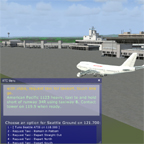
Interactive air traffic control (ATC) is one of the most exciting features of Flight Simulator. You'll have plenty of company in the skies, and you can ask for and receive clearances, be warned of air traffic near you, get vectors, and hear controllers speaking to other aircraft.
You do not have to interact with the ATC system in order to fly in Flight Simulator; ATC is an enhancement to the Flight Simulator world, but you can still fly from one place to another without communicating with anyone until you're ready to use the ATC system. When you start using ATC in Flight Simulator, take advantage of the Autotune feature, which can tune the radio for you and lessen your workload. (For more information, see Using the Autotune Feature.)
Multiplayer ATC and Shared Aircraft
In multiplayer mode, you can connect over the Internet or a LAN to be an air traffic tower controller for Flight Simulator pilots or interact with a live Flight Simulator Tower Controller.
How about live instruction on any aspect of using Flight Simulator or on flying? You can give or receive instruction with another pilot or a friend over the Internet or a LAN using Flight Simulator's Shared Aircraft feature in multiplayer. To learn more, see Sharing the Aircraft in Multiplayer in the Learning Center.
Remember that if you use Multiplayer ATC in Flight Simulator, there really is no difference between ATC in the real world and ATC in Flight Simulator. To learn more, see Multiplayer Air Traffic Control in the Learning Center.
|
Learning More about ATC No single article can provide an extensive education in all the complexities of the real-world air traffic control system, but after reading this page you'll have enough information to use the ATC system in Flight Simulator. Along the way, we'll include references that will let you explore the wider world of ATC and radio communications. Our partner, the Aircraft Owners and Pilots Association (AOPA), also offers a wealth of information about all aspects of flying. |
Although the Learning Center's ATC articles include advanced topics for instrument-rated pilots, this isn't some secret information that you're barred from if you're a novice. Once you get more experience under your belt and learn the system, you can make use of the advanced topics, too. For help with unfamiliar terminology, see the ATC Glossary.
Novices
If you're new to Flight Simulator, you'll have more fun if you first learn to fly using the Flight Academy. Once you feel comfortable at the controls of one or more of the Flight Simulator aircraft, take the time to read through the various ATC articles and learn how to use ATC and radio communications. You'll need to understand how the system works and have a basica familiarity with the language of ATC. Beginners often find the Autotune feature helpful; it will tune your radios to new frequencies automatically (see Using the Autotune feature).
Intermediate Users
If you're an experienced Flight Simulator user but are unfamiliar with air traffic control, take time to read through the Learning Center's ATC articles. You'll learn how the ATC system works and learn how to operate within that system in Flight Simulator.
Advanced Users
If you're a pilot or experienced simulator user, you may want to jump to the sections Using ATC in Flight Simulator and Real-World Differences.
Getting Started in ATC
Remember to use the numbers along the top of the keyboard when making choices from the ATC menu. The numbers on the numeric keypad (usually on the right side of the keyboard) are assigned to other functions in Flight Simulator.
|
To learn more about using the Air Traffic Control menu, see Using the ATC Menu. |